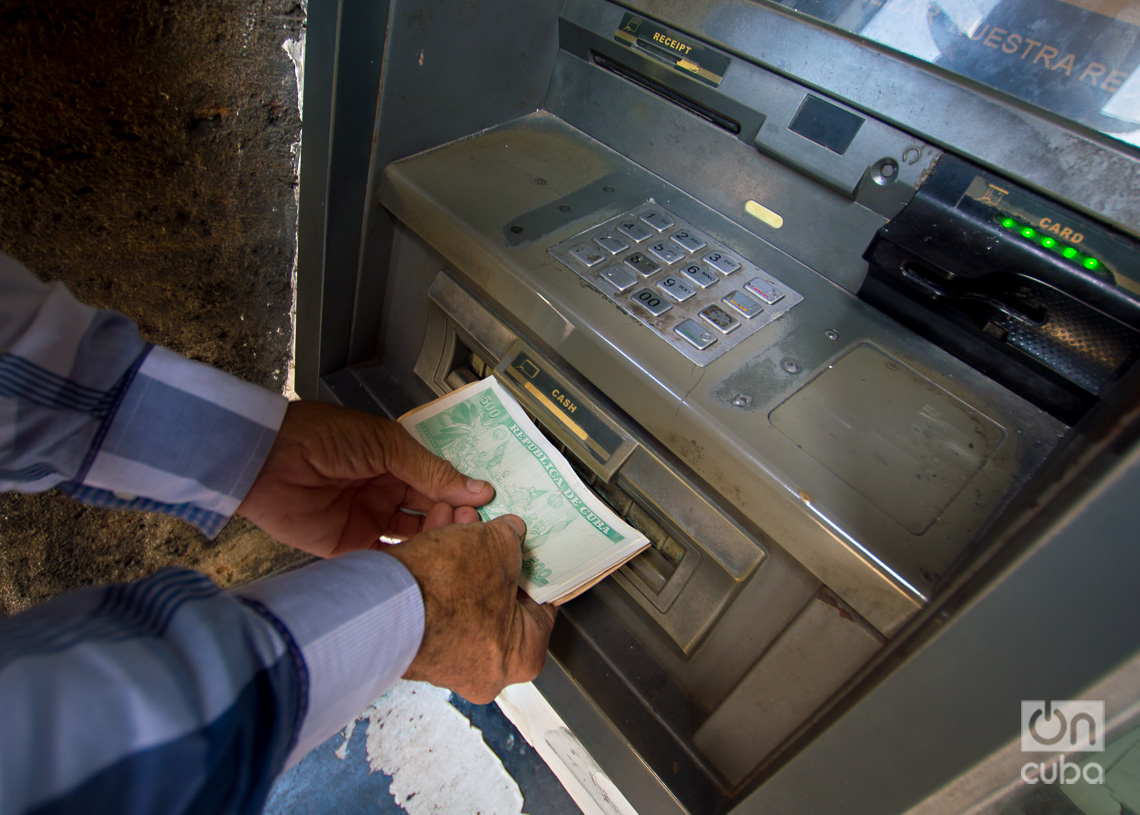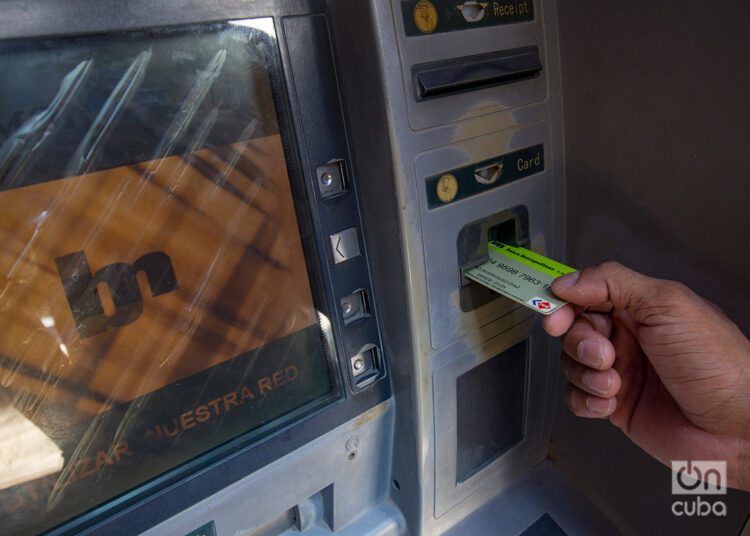It was not until after two days of fruitless queues that Omar found a way to collect his pension, which since March he had not been able to cash. The solution was provided to him by a co-worker, a retiree and hired guard like him, who had also been living for months only on his current salary, given the impossibility of accessing his checkbook.
Following his advice, before dawn the morning after that conversation, Omar left by bicycle for the Camagüey airport, his destination being the Cadeca exchange office in the international terminal. It was there that he finally managed to extract the 5,000 pesos accumulated over three months from the virtual piggy bank.
“I had to travel about 30 kilometers to and from my house, and stand in line for more than two hours, because when I arrived there were already people waiting for the same thing, but, in any case, I felt I was lucky. That afternoon, on my way to work, when I passed by the bank I met many acquaintances from my days in line. They kept waiting for the power to come on to see if the ATMs could be reloaded. Were those the ‘successes’ they were looking for with the bancarization?” he questioned.

Promising future?
In April, the provincial department of the Banco de Crédito y Comercio (Bandec) in Sancti Spíritus announced it would stop replenishing the province’s ATMs. Residents interested in withdrawing money from their accounts should do so through the cashier service inside the branches, with a limit of 5,000 pesos per day.
The decision sought to close the path to “backpackers,” people who “are willing to lend their names and personal bank cards so that money can be transferred from MSMEs and self-employed workers to come and make the withdrawal through the ATMs,” explained a local Bandec official. With their improvised business, the “backpackers” monopolize the ATMs, preventing ordinary customers from getting cash.
The measure of closing ATMs has so far not been replicated in other provinces. Obstacles that may have prevented this include two that are difficult to solve: a lack of cash and bank workers.
Already last November, the then president of the Central Bank of Cuba ― current Minister of Economy and Planning ―, Joaquín Alonso, recognized the existence of a growing phenomenon of “cash retention,” which he described as “harmful” to the national economy but against which the government did not have a defined strategy. He also did not have solutions for the “significant undercapitalization” of the workforce that the sector is suffering. “Two contradictory aspects come together: we increase the checkout lines with more cubicles, and every day we lose more cashiers. Despite the increase we have made in terms of salaries,” he noted.
However, at that Mesa Redonda TV program, Alonso insisted on anticipating a promising future, highlighting that since the beginning of bancarization — in August 2023 — digital operations (payments, transfers, etc.) had experienced an average monthly increase of 0.6%, and that on issues of such urgency as the sale of foreign currency, work was being done to “identify solutions in accordance with the capabilities that we are creating,” he said.
Six months later it remains a mystery what he was referring to. In the time that has gone by, the measures to stop the exodus of banking professionals have not been effective, nor has the trend towards the accumulation of money in the hands of individuals been reversed, nor has a formal foreign exchange market been created to help contain the devaluation of the peso concerning the dollar and other currencies.
To make matters worse, since the end of February, the provinces have been experiencing a new chapter of the energy crisis that the country has been suffering for years — with blackouts of up to 21 hours a day, only comparable to those of the most difficult moment of the Special Period. The lack of electricity has among its first losses telephone services, essential for transfer payments, and also affects the operations of ATMs and bank branches.
“It is no longer just the tremendous sacrifice that has to be made to buy a cell phone and be lucky enough to find an MSME that wants to charge by transfer. In addition, it is time to pray to get a connection flash and for Transfermóvil to fail. And if it involves getting out money that belongs to you, things get worse. It doesn’t matter if it’s at the ATMs or the bank. Yes, even at the bank in the Plaza de los Trabajadores, which is the main one, they have cut their hours to serve fewer people. Now they close at twelve, and many times they don’t even work because they say they are offline!” criticized Omar, a resident of Camagüey.
“What happens is that they don’t have money, and that’s why they drag their feet so that people get upset and don’t come,” added an elderly woman who, at the end of May, sitting under one of the few trees in the Plaza de los Trabajadores, was waiting for four ATMs located in the place to be supplied.
It was after ten in the morning and since the previous noon the ATMs had been empty, said another member of the queue, scattered throughout different parts of the square. “It doesn’t matter that the ATMs are in the Bandec [provincial department] building itself and that now they don’t turn off this circuit in the mornings. They only put money in them once a day, and sometimes not even that. We people spend a lot of days waiting to withdraw our money while the bank bosses enter and leave their offices as if it were none of their business,” she questioned.
Unlike what happens in Havana, where Banco Metropolitano has been opening several of its branches on Sundays for months to deliver cash to the population, in the interior of the country neither Bandec nor Banco Popular de Ahorro have considered providing that service — Banco Metropolitano only operates in the capital.
Given the difficulties in accessing cash through ATMs and bank branches, the official recommendation is that people use “digital payment channels” or alternatives such as extra cash registers, among those most affected by the energy crisis.

So not a single dollar gets away
In the queues of practically any provincial bank, few moments compare to what occurs when someone arrives to deposit cash. It doesn’t matter if you carry foreign currency or national currency, the line moves aside for the newcomer without a hint of protest and the doorman eagerly clears the entrance, intending to complete their procedure as soon as possible.
Many times, that money is the same given to those who come to make withdrawals, revealed a Camagüey bank worker. “Due to lack of funds, on some days we have had to reduce the number of withdrawals from 5,000 to 3,000 pesos. And, logically, people get upset.”
The current crisis was foreseeable since in January 2023 the Central Bank decided to “update” the límits of operations carried out by individuals through their electronic accounts. For those corresponding to Cuban pesos, maximums of 80,000 pesos daily and 120,000 monthly were established, and for those of MLC (freely convertible currency), 1,000 per day and 5,000 monthly.
“There is an international practice of applying due diligence in banks and, within it, establishing limits on client transactions,” declared the Central Bank, in a note that assured that these limits had been set in Cuba since 1997.
Among the justifications that were used to reimpose the limits amid the complicated post-pandemic economic scenario were that it would contribute to “preserving market discipline” and “preventing [citizens] from getting involved, knowingly or not, in illicit actions or tax evasion,” according to the aforementioned note from the Central Bank.
As happened when defending the convenience of the bancarization process — seven months later — the official discourse appealed to international examples that were difficult to extrapolate to Cuba. However, it was evident that the measure was intended to intervene in the informal exchange market, which was growing exponentially due to the development of MSMEs. Instead of participating in currency trading, the government opted for banning the informal exchange market.
It was a complete failure, with effects such as that this trade, which until then was largely supported by digital platforms, began to be carried out in cash.
Later, the Central Bank (BC) itself insisted on ignoring other expert recommendations, such as printing higher denomination banknotes.
In August of last year, the economist Oscar Fernández analyzed on his Facebook profile the impact that inflation and the already established distrust of individuals and the private sector towards the banking system had on the peso. For it to continue fulfilling its functions, it was necessary to expand its monetary cone, he warned. “If in conditions of low bancarization, the BC does not increase the denomination of the banknotes, it will obviously have to put more banknotes into circulation so that the same operations can be carried out, with the consequent increase in costs that this entails. We would need 5,000 and 10,000 CUP bills to facilitate economic operations,” Fernández noted on the social media.
But the Central Bank has denied several times rumors about the entry into circulation of larger bills. So far, no significant measure taken by the government to solve the cash crisis can be pointed out. As in other crises, the official line of behavior seems to be based on contingency solutions like the one adopted in Sancti Spíritus and the hope that — somehow — things will fix themselves. Little or nothing for the thousands of Cubans who struggle every day to have their money.
“I have no way of getting the pension from the card. But if tomorrow I was told they would stop paying my contract as a guard through payroll and do it by transfer, I would stop working right there,” Omar confessed to OnCuba. On the day we spoke, his next retirement pay was almost a month away. He was already lamenting, imagining the several-day queues that he would have to stand in to collect it.










